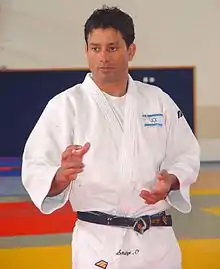Ofakim
Ofakim (Hebrew: אֳוֹפָקִים, lit. "horizons") is a city in the Southern District of Israel, 20 kilometers (12.4 mi) west of Beersheba. It achieved municipal status in 1955. It has an area of 10,000 dunams (~3.9 sq mi; 10 km2). In 2019 it had a population of 30,662.[1]
Ofakim
אֳוֹפָקִים | |
|---|---|
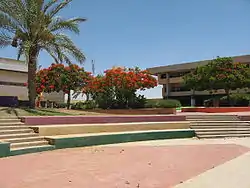 | |
 | |
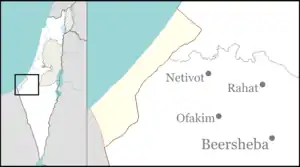 Ofakim 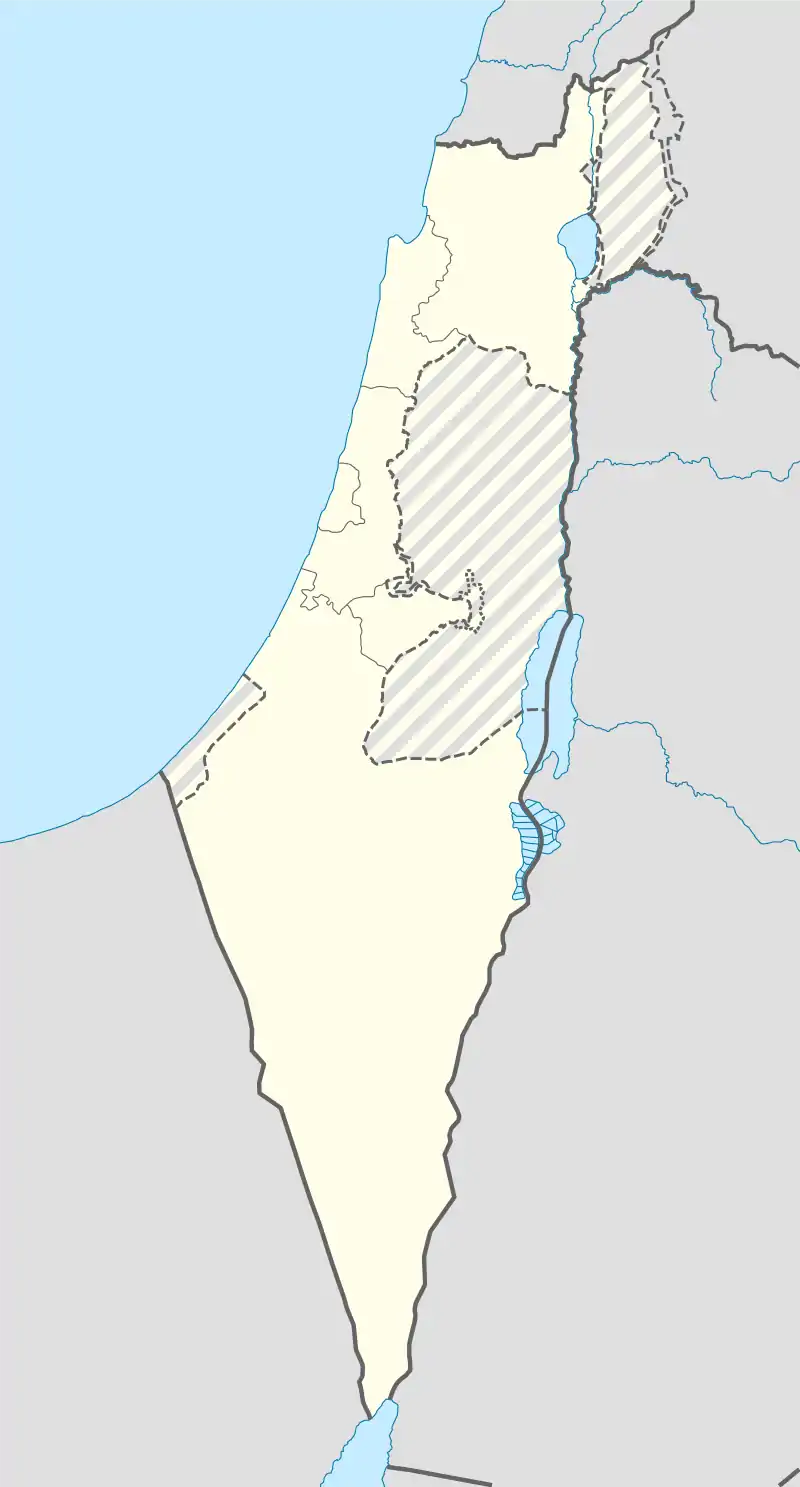 Ofakim | |
| Coordinates: 31°19′N 34°37′E | |
| Country | |
| District | Southern |
| Founded | 19 April 1955 |
| Government | |
| • Mayor | Yitzhak Danino |
| Area | |
| • Total | 10,273 dunams (10.273 km2 or 3.966 sq mi) |
| Population (2019)[1] | |
| • Total | 30,662 |
| • Density | 3,000/km2 (7,700/sq mi) |
| Name meaning | Horizons |
| Website | http://www.ofaqim.muni.il |
Established as a development town in 1955, Ofakim was for many years a major textile manufacturing center. Outsourcing of textile manufacturing outside Israel caused economic stagnation, and Ofakim suffered high poverty and unemployment rates for many years. Since then, new factories have moved in, and the city is currently undergoing major development.
History
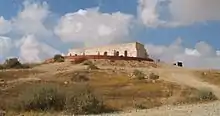
Ofakim was established in 1955 as an urban center for the rural communities in the area.[2][3] The first inhabitants were immigrants from Morocco and Tunisia. The population in 1955 was about 600. The inhabitants initially lived in huts and tin shacks, but the construction of permanent housing proceeded rapidly, and the construction industry was the main source of income during the early years. In late 1956, after Jewish refugees expelled from Egypt following the Suez Crisis arrived in Israel, 150 Egyptian-Jewish immigrant families, including some Karaite Jews, came to Ofakim. In the following years, 170 Jewish families from Iran arrived, as did additional immigrants from India and Romania. In 1958, Ofakim was granted local council status.
In the late 1950s, the construction industry was still the main employer, and some residents also worked in agriculture nearby, but industry also began to be established in Ofakim, starting with a diamond polishing plant, followed by two textile factories that opened in 1959. At the same time, the town's streets were paved, public parks were established, and schools were founded. In 1961, the population was 4,600.
As in other development towns, the industrial sector historically played an important part in Ofakim's economy. In 1972, 32% of the salaried workers (754 people) were in this sector, and in 1983—924 people (23%). During this period, the textile industry grew to dominate Ofakim's economy. Numerous textile plants were set up, and the industry employed by far the most workers, ranging from 72% (1982–83) to 82% (1972). The Of–Ar (short for Ofakim–Argentina) textile factory was a major employer.[4] In 1983, the population had grown to 12,600.
Ofakim's economy declined after Israeli textile manufacturers began closing their factories in Israel to move their production to other countries with lower labor costs, mainly in Southwest Asia, and to Egypt and Jordan after Israel signed peace treaties with those two countries. Starting in the mid-1980s, the city's textile mills began to shut down, with the last one closing in 1995, rendering much of the population unemployed. In the early 1990s, during the mass migration of Jews from the former Soviet Union to Israel, more than 7,000 Soviet immigrants arrived in Ofakim, and were provided with heavily subsidized housing. This fueled further competition for jobs, and due to the fact that Soviet immigrants were typically better educated than the mainly unskilled or semi-skilled veteran population, they were better able to get the few jobs available. The city also absorbed immigrants from Ethiopia during this time. A few more plants moved into the city in the 1990s, including an electronics factory in 1996, but unemployment remained high.[5] Ofakim gained a reputation as an economically depressed city in Israel.
In 1997, it had the highest unemployment rate in Israel, at 15.3%.[6] It also had the highest unemployment rate in 2004, at slightly over 14%.[7] In 2008, Haaretz reported: "Nearly one-third of the inhabitants are supported by the welfare department and hundreds of families receive aid, including food, from non-profit organizations. Many of the inhabitants in their 50s and 60s have been dreaming of fleeing Ofakim since they were 20. When they retire, they leave."[8]
In the 2007, the Israeli Interior Ministry dismissed Ofakim mayor Avi Asaraf and his entire city council from their posts for failing to implement a recovery plan for Ofakim.[9] Zvika Greengold became the new mayor.
Throughout the 2000s and 2010s, Ofakim gradually saw improvements in its economy. Tax incentives were given to open new factories in Ofakim, and a branch of MATI, an organization that supports small businesses, was opened. The high-tech industry also entered Ofakim. The city is currently undergoing a series of major development projects.
Demographics
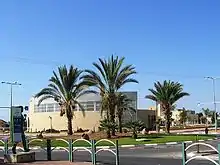
In 2010, about one-fifth of the residents were ultra-Orthodox and one third were immigrants from the former Soviet Union. Most of the rest were members and descendants of the founding generation of the immigrants who arrived in the town in the 1950s and 1960s. In addition, there are small communities of Ethiopian Jews and Palestinians originally from the Gaza Strip who were resettled in Israel after collaborating with Israeli authorities.[2][3]
According to the Central Bureau of Statistics, Ofakim had a population of 25,638 in December 2015, and the population is growing at a rate of 1.4% a year.
Economy

In 2013, about 40% of Ofakim's residents worked in the city. There were about 20 factories in Ofakim on 2,000 dunams of land. Some residents also work in high-tech.[10]
Education
In 2001, there were 21 schools and 4,704 students in the city – 13 elementary schools (3,079 students), and 8 high schools (1,625 students). 43.3% of 12th grade students were entitled to a matriculation certificate.
Sports
One of Israel's 14 tennis centers is located in Ofakim.[11] It opened in 1990 and has six courts. The city also has a soccer stadium.The Nahal Shomriya cycling route around Ofakim was inaugurated in 2010. The 60-centimeter-wide single route winds through 1,500 dunams (approx 375 acres) in Ofakim Forest, passing through Nahal Shomriya and Nahal Patish, and looping around eight local moshavim.[12]
Urban development plans

The city has begun to develop from 2015 onward after years of stagnation. Thousands of new housing units, commercial and employment centers, and a youth center which included a cinema were built. Ofakim Railway Station was completed in December 2015 with a car park for 1,000 cars.[8] Next to the train station, a new neighborhood specially designed to have affordable prices for young people, is being built as part of the "Noah Initiative", which was started by activists from Tel Aviv.[13][14]
In 2017, a new agreement was signed to build 14,436 housing units in four new neighborhoods and one established neighborhood, which will greatly increase the city's population. In addition, the agreement stipulated the development of an industrial zone in southern Ofakim, increased funding for infrastructure and urban renewal projects, and the construction of a new road between Ofakim and Ramon Airport. The plan aims to double the city's population.[15][16] High-rise construction of buildings up to 13 stories is also planned.
Notable residents
- Shimshon Pincus, rabbi
- Oren Smadja, Olympic judoka
- Robert Tiviaev, former Knesset member
References
| Wikimedia Commons has media related to Ofakim. |
- "Population in the Localities 2019" (XLS). Israel Central Bureau of Statistics. Retrieved 16 August 2020.
- "Go south, young men (and women)". Haaretz.
- http://www.haaretz.com/print-edition/features/new-horizons-for-ofakim-1.256467
- Schwarz, Dafna (2009). "Industrialization Attempts in Three Development Towns: Ofakim, Migdal HaEmek and Ma'alot". In Halamish, Aviva; Meir-Glitzenstein, Esther; Tzameret, Zvi (eds.). The Development Towns. Idan Series Vol. 24 (in Hebrew). Yad Yitzhak Ben Zvi. pp. 160–162. ISBN 978-965-217-298-3.
- https://articles.latimes.com/1998/feb/13/news/mn-18717
- http://www.globes.co.il/en/article-367647
- http://www.haaretz.com/unemployment-falls-but-do-statistics-lie-1.148115
- New Horizons for Ofakim
- "Ofakim Mayor, City Council Dismissed for Failing to Implement Recovery Plan". The Jerusalem Post. August 29, 2007. Retrieved April 16, 2019.
- http://www.nbn.org.il/gosouth/community_profile/ofakim/
- Tennis doubles coexistence program
- KKL (February 22, 2010). "Riding and Building New Ofakim - Shomriya Cycling Route". The Jerusalem Post. Retrieved April 16, 2019.
- Tress, Luke (May 11, 2016). "Building anew in the Negev". The Times of Israel. Retrieved April 16, 2019.
- http://www.maariv.co.il/news/new.aspx?pn6Vq=J&0r9VQ=FDGJL
- https://www.jfedgmw.org/access/access-federation-6-6-17/the-new-ofakim-pact
- "Agreement for 14,000 Housing Units Just Signed". Globes. May 29, 2017. Retrieved April 16, 2019.
External links
- Weaving community: Labour in Ofakim
- Works of communal art
- Survey of Western Palestine, Map 24: IAA, Wikimedia commons
